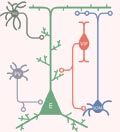Thursday, 15 October 2015
Inhibitory Neurons: More Than Just a Brake

Neuroscientists have known that the brain contains glial cells just as long as they have known that it contains neurons, but only in the past two or three decades have scientists discovered the actual importance of glial cells for communication within the brain. Similarly, neuroscientists have long known that between the large excitatory neurons of the cerebral cortex, there are a multitude of small inhibitory neurons. Once thought to act as simple “brakes” on brain activity, these inhibitory neurons have gradually been found to display far more complex variations in their nature, form, connectivity and function than was originally believed.
The brake metaphor is certainly not inaccurate. A dysfunction in certain of these interneurons can gradually cause the nerve impulses between the excitatory neurons to race out of control, resulting in a veritable electrical storm inside the brain: an epileptic seizure.
Conversely, augmenting this natural brake on brain activity is one way to dampen certain “higher” functions that tend to get out of control and create all sorts of anxiety-producing scenarios in human beings. That is why some people take certain prescription tranquilizers (such as benzodiazepines) or consume non-prescription tranquilizers (such as alcohol) to help calm themselves a bit, or, in the case of alcohol (which despite being legal is still toxic in high doses) simply to “untie their tongues” in social situations, All this basically means is that our social inhibitions, which are generally highly cortical, are partly alleviated by potentiation of these inhibitory neurons that use GABA as a neurotransmitter. And in fact, it is known that both benzodiazepine molecules and alcohol molecules bind to the excitatory neurons’ GABA receptors, thus helping them to open. Since these channel receptors are permeable to negatively charged chlorine ions, they hyperpolarize the membranes of the excitatory neurons and thus make them less excitable.
But as the website Knowing Neurons reported in November 2014 (see links below), in coverage that included an interview with Dr. Gordon J. Fishell, who studies inhibitory neurons, these neurons may play several other roles as well, especially in explaining affective disorders, some of them, once again, anxiety-related. For example, the connections between physical exercise, the neurogenesis of GABA neurons in the hippocampus, and the reduction of anxiety have been clarified by the work of Dr. Elizabeth Gould and her research team.
Inhibitory neurons (also known as inhibitory interneurons, an allusion to their evolutionary origin, in which they appeared between the sensory and motor neurons) also appear to play an important role in helping to organize the entire network of cortical neurons during the development of the human embryo. How? Here’s where nature has yet another surprise in store for us: by depolarizing other neurons by sending them GABA which, later on, will have exactly the opposite effect on the mature neurons, hyperpolarizing them and thus distancing them from the threshold for triggering nerve impulses! One possible explanation for this seeming paradox is that the immature neurons may not have the same receptors as the mature ones.
![]() Inhibitory Neurons: Keeping the Brain’s Traffic in Check
Inhibitory Neurons: Keeping the Brain’s Traffic in Check
![]() Science Fiction, Serendipity and Interneuron Specification: A Conversation with Dr. Gordon J. Fishell
Science Fiction, Serendipity and Interneuron Specification: A Conversation with Dr. Gordon J. Fishell
![]() A Conversation with Gordon Fishell
A Conversation with Gordon Fishell
![]() The Integration of Interneurons Into Cortical Circuits: Both Nurture and Nature – Gordon J. Fishell
The Integration of Interneurons Into Cortical Circuits: Both Nurture and Nature – Gordon J. Fishell
Mental Disorders | Comments Closed







